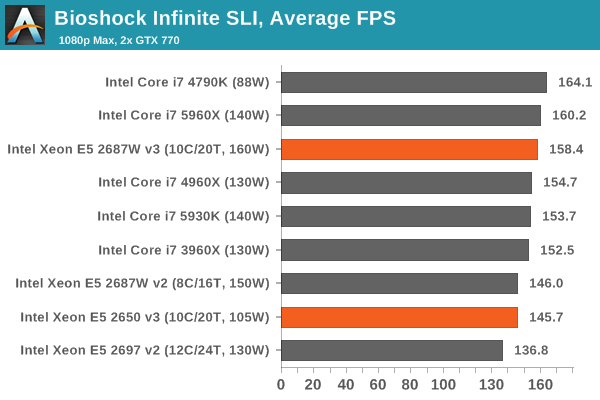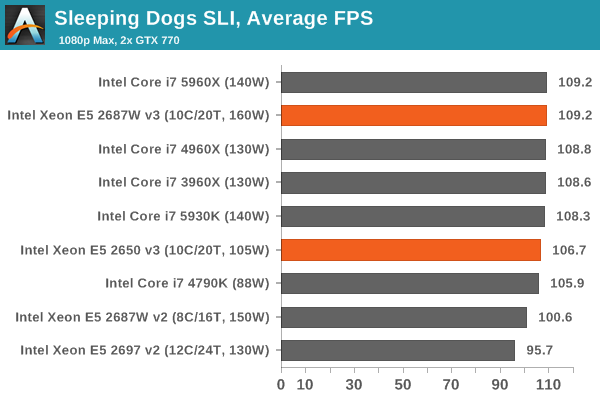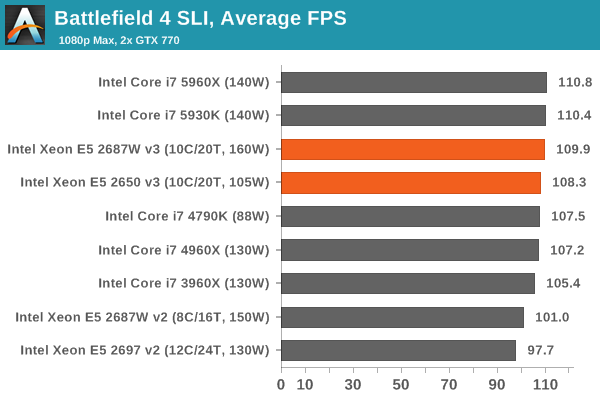Intel Xeon E5-2687W v3 and E5-2650 v3 Review: Haswell-EP with 10 Cores
by Ian Cutress on October 13, 2014 10:00 AM EST- Posted in
- CPUs
- IT Computing
- Intel
- Xeon
- Enterprise
- Enterprise CPUs
Gaming Benchmarks
F1 2013
First up is F1 2013 by Codemasters. I am a big Formula 1 fan in my spare time, and nothing makes me happier than carving up the field in a Caterham, waving to the Red Bulls as I drive by (because I play on easy and take shortcuts). F1 2013 uses the EGO Engine, and like other Codemasters games ends up being very playable on old hardware quite easily. In order to beef up the benchmark a bit, we devised the following scenario for the benchmark mode: one lap of Spa-Francorchamps in the heavy wet, the benchmark follows Jenson Button in the McLaren who starts on the grid in 22nd place, with the field made up of 11 Williams cars, 5 Marussia and 5 Caterham in that order. This puts emphasis on the CPU to handle the AI in the wet, and allows for a good amount of overtaking during the automated benchmark. We test at 1920x1080 on Ultra graphical settings.

Bioshock Infinite
Bioshock Infinite was Zero Punctuation’s Game of the Year for 2013, uses the Unreal Engine 3, and is designed to scale with both cores and graphical prowess. We test the benchmark using the Adrenaline benchmark tool and the Xtreme (1920x1080, Maximum) performance setting, noting down the average frame rates and the minimum frame rates.

Tomb Raider
The next benchmark in our test is Tomb Raider. Tomb Raider is an AMD optimized game, lauded for its use of TressFX creating dynamic hair to increase the immersion in game. Tomb Raider uses a modified version of the Crystal Engine, and enjoys raw horsepower. We test the benchmark using the Adrenaline benchmark tool and the Xtreme (1920x1080, Maximum) performance setting, noting down the average frame rates and the minimum frame rates.

Sleeping Dogs
Sleeping Dogs is a benchmarking wet dream – a highly complex benchmark that can bring the toughest setup and high resolutions down into single figures. Having an extreme SSAO setting can do that, but at the right settings Sleeping Dogs is highly playable and enjoyable. We run the basic benchmark program laid out in the Adrenaline benchmark tool, and the Xtreme (1920x1080, Maximum) performance setting, noting down the average frame rates and the minimum frame rates.

Battlefield 4
The EA/DICE series that has taken countless hours of my life away is back for another iteration, using the Frostbite 3 engine. AMD is also piling its resources into BF4 with the new Mantle API for developers, designed to cut the time required for the CPU to dispatch commands to the graphical sub-system. For our test we use the in-game benchmarking tools and record the frame time for the first ~70 seconds of the Tashgar single player mission, which is an on-rails generation of and rendering of objects and textures. We test at 1920x1080 at Ultra settings.
















27 Comments
View All Comments
personne - Monday, October 13, 2014 - link
This review should be called Intel Xeon E5-2687W v3 and E5-2650 v3 on Windows Review. I'd think a large number of these servers would be used for other operating systems.Ian Cutress - Monday, October 13, 2014 - link
I have some Linux benchmarks in the pipeline that I'm testing but aren't ready for prime time yet.I'll need to get some CPUs back in my office to test with that though, these Xeons are usually only loaner samples and it gets difficult to retest them.
personne - Monday, October 13, 2014 - link
Thanks. I admit it really aggravates me, in 2014, to see screenshots of applications as some sort of qualifier. So I hope you can generate some really useful discrete data for a critical audience.Marthisdil - Monday, October 13, 2014 - link
I think a large number of these servers will be used in ESX (or other hypervisor) hosts, so these benchmarks don't really mean a ton.Flunk - Tuesday, October 14, 2014 - link
This review is all workstation loads, so it's not that helpful even if you are using Windows. I think most of the Windows Systems these very pricey Xeons end up in will be servers. IIS, database and active directory performance testing would be more appropriate.elerick - Monday, October 13, 2014 - link
I do find some value in the benchmarks proved by this review. For a review to include a high end workstation with DDR4 to have gaming benchmarks it proves that game engines do not take advantage of the extra bandwidth. The only factor is CPU architecture @ frequency + graphics cards.I would have liked to see how this CPU handles server applications and storage such as ZFS. More and more converged infrastructure is becoming hardware vendor agnostic ESXi 6 has some pretty cool features that make sense with Super Micro hardware taking advantage of the latest CPU
iwod - Monday, October 13, 2014 - link
I think next year Xeon will be much more interesting with 14nm. I am hoping to see an increase from 12 to 16, and 18 to 24/32 Core. Along with much cheaper DDR4.Jon Tseng - Monday, October 13, 2014 - link
Hey Ian any more thoughts on power consumption vs. Ivy Bridge in day-to-day use, not just load.To me the obvious advantage of Grantley on paper is bringing all that Haswell power-gating/idle goodness to the server environment. The technology which lets Haswell spin out battery life in a laptop should also deliver energy and cost savings in a DC - which matters given power consumption (this is assuming your DC has decent periods of under-utilization - i.e. not an HPC plant!).
Curious if any thoughts/data on this... J
isa - Monday, October 13, 2014 - link
I feel personally threatened by the "idea-limited" constraint. I resemble that remark. But I compensate with kool LEDs on my PC.Carl Bicknell - Monday, October 13, 2014 - link
One thing that really needs spelling out is the clock speed under full load on all cores. That's much more informative than giving the default or the range.For the 2687W it's 3.2GHz default, and 3.4Ghz with turbo on all cores. That's pretty disappointing Intel.